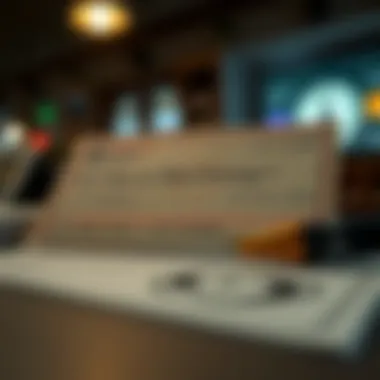Mastering the Art of Check Writing: A Complete Guide


Intro
Writing a check might seem like a forgotten skill in today's digital age, but it carries weighty significance for personal finance management. While mobile payments and e-transfers are increasingly dominating the landscape, checks remain a valuable tool for many individuals and businesses. This guide aims to break down the essential elements of writing a check, the importance of each part, and to highlight common pitfalls that people often experience.
Understanding the landscape of checks not only enhances your financial literacy but also equips you with the skill to handle transactions that may require a traditional written format. Let’s dive into the core components of writing a check, ensuring you have a clear, comprehensive grasp of the process, regardless of your previous experiences.
Prolusion to Writing Checks
Writing checks may seem like a routine task, but it carries significant weight in the realm of personal finance. Understanding how to properly write a check not only ensures that payments are made effectively, but also safeguards against potential mistakes that can lead to financial hiccups. Mastery of this skill allows individuals—whether they are college students managing expenses or seasoned professionals handling larger transactions—to navigate their financial obligations with confidence.
When we discuss writing checks, we are delving into a practice that embodies trust between parties. It’s a document that facilitates a promise, a promise that what is written—in terms of amount and information—will be honored by the bank holding the account. Essentially, mastering this skill can free one from the shackles of cash transactions, providing a more secure and traceable method for conducting business.
In today’s fast-paced financial landscape, checks remain relevant despite the rise of electronic payment methods. Their tangible nature can be advantageous in various situations, offering protection through a paper trail that electronic transactions may lack. Moreover, as we explore the deeper aspects of writing checks further in this article, we'll touch upon various components and considerations that can either enhance or hinder this process.
Understanding the Purpose of a Check
Checks serve a multifaceted purpose in financial exchanges. For many people, a check is simply a means to pay bills, but it embodies much more than that. At its core, a check represents a signed pledge to pay a specific sum of money from one individual to another, which can be especially essential in transactions that require a clear record or when dealing with service providers.
- Record Keeping: Checks offer a defined paper trail, which can simplify tracking personal and business expenditures. This is beneficial not only for personal budgeting but also for tax purposes.
- Trust and Security: Sending a check can be seen as a trust gesture. It requires that the payer has the funds available in their bank account, which the payee can verify.
- Flexibility in Amounts: Whether it's a small utility bill or a large expense such as rent, checks can be written for any amount, making them adaptable based on individual needs.
In instances where digital methods may be convenient, checks still hold a peculiar appeal. This is particularly true for transactions involving larger sums where one might not feel comfortable wiring money or entering credit card information online.
Relevance of Checks in Today's Financial Systems
The relevance of checks today is often underappreciated, particularly in the face of modern banking solutions such as mobile wallets and cryptocurrencies. Yet, checks still play a critical role for certain demographics, transcending the limitations of technology.
- Aging Population: Many older individuals prefer checks, as they are familiar and often feel more secure using them rather than adopting newer technologies. In this case, checks provide a reliable method for managing their financial transactions.
- Business Transactions: In the realm of business, checks can be preferable for vendors who may not accept credit cards or electronic payments. Businesses can write checks for payments to contractors, service providers, or suppliers, ensuring that transactions are documented and easily traceable.
- Legal Considerations: There are situations where checks are necessary for compliance or legal reasons. For example, certain payments such as court settlements or divorce settlements often require checks rather than electronic transfers for proper record keeping.
Components of a Check
Writing a check requires one to navigate various essential components that collectively ensure its effectiveness and security. Each element plays a crucial role, both in terms of functionality and legal validity. Understanding these components fosters familiarity and confidence in utilizing checks as a payment method. Below, we delve into the key parts that constitute a check, emphasizing their significance in the check-writing process.
Payee Line
The payee line is where you name the individual or entity that will receive the funds. It's located prominently at the top of the check. Including the correct name here is more than a formality; it acts as a binding contract. If you input the wrong name, the check is effectively worthless to the intended recipient. This line also needs to be legible to avoid confusion, which could lead to delays in payment.
Be diligent to check the spelling and full name, especially if the payee is a business or organization. An oversight could cause unnecessary hassle later.
Date Line
The date line, positioned directly beneath the payee line, indicates when the check was written. This date is important since it helps establish when the transaction occurred. Knowing the date also aids in record-keeping both for you and the recipient. If you forget to write a date, it can create confusion about when the check can be cashed. For practical reasons, it’s advisable to use the current date.
Numeric Amount Box
This is where you write the amount of money in numerical form—clearly and in the format that prevents tampering. The numeric amount box serves as a quick-reference point for both the payer and the payee. Additionally, it minimizes the risk of misinterpretation, as numbers written poorly can lead to misunderstandings. Ensure there’s no extra space in this field to prevent alterations.


Written Amount Line
Right below the numeric amount box, you will find the written amount line, where you convert that numerical figure into words. This addition is crucial, as it provides a backup in case there’s a discrepancy between the numbers and the written words. It's not uncommon for disputes to arise from poorly written checks, thus always ensure that this line is correctly filled in. When in doubt, write it clearly and completely.
Signature Line
The signature line is your stamp of approval—the final touch that legitimizes the check. This signature must match the one on file with your bank. Without a proper signature, the check is not valid. Hence, exercise caution when signing; many financial institutions require it to be identical to the one they have in their records. Your signature verifies your permission for the transaction that the check represents.
Memo Field
While not mandatory, the memo field acts like an additional note to explain the purpose of the payment. This could be a simple reminder for yourself or information for the payee, like "Rent for October". It does provide clarity, especially when you are dealing with multiple checks. Sometimes, it helps in tracking personal expenses, which can be handy during tax season.
Routing and Account Numbers
Found at the bottom of the check, these numbers identify your specific bank and your account. The routing number directs the banks to the correct institution, while your account number designates which account the funds should come from. Remember that these numbers are crucial in ensuring successful transactions, and mishaps here can lead to misdirected funds or charges. Double-checking these numbers before handing over a check is fundamental for maintaining your financial integrity.
Step-by-Step Guide to Writing a Check
Writing a check isn’t as simple as penning down your name and a number; it involves a systematic approach to ensure accuracy and avoid unpleasant surprises. Each step has its importance in the process, not just for immediate transactions but also for maintaining financial security. Understanding these steps can greatly enhance one's ability to manage funds effectively and confidently. This guide will walk you through each phase, detailing what to consider and highlighting pitfalls to avoid.
Gather Necessary Materials
Before you put pen to paper, it’s crucial to have everything on hand. You will need a checkbook, a reliable pen, and perhaps a calculator if you plan on doing some number crunching. Take a moment to ensure that you’re in a quiet space to focus. Jotting down the relevant details on a piece of scratch paper can also help streamline the process.
Filling Out the Payee Information
The payee line is where you designate who the check is for. This can either be a person or a business. Be specific when entering this information; for instance, miswriting the payee's name can lead to complications. If the check is made out to a person, it's best to use their full name. For businesses, ensure you spell out the exact name since some organizations might have similar ones. Not taking the time for clarity here can result in the check not being honored.
Entering the Date
The date line should reflect when the check is being written. This date can have financial implications, particularly when it relates to the availability of funds. For most transactions, writing today’s date suffices. However, some folks might write a future date if they're preemptively paying for something or to keep their payments organized. Remember, writing a date too far in the future could lead to confusion or even backfire on your account if someone tries to cash it early.
Specifying the Amount
This step involves filling in two areas: the numeric amount box and the written amount line. In the numeric box, write the total you intend to pay, ensuring it aligns perfectly with what you put in words. For example, if you write "100.50" numerically, make sure it says "One hundred dollars and 50 cents" clearly in the written section. Going off-script here can lead to a mess, as the bank usually honors the written words over numbers when there's a discrepancy. Be precise, because errors can cause delays or even bounce the check entirely.
Signing the Check
The signature line completes the transaction, so it can't be overlooked. Your signature should match what the bank has on file. If your signature is slightly different, it can raise eyebrows at the bank, causing delays. Just a slight variation could potentially invalidate the check or lead to unwanted questions. Take a moment to sign with confidence; after all, this is your commitment to pay.
Including a Memo (if necessary)
While including a memo isn’t mandatory, it can be beneficial for both parties. It serves as a reminder of the purpose of the payment. For example, writing "Utilities for November" might clarify the transaction for both you and the payee later down the line. If you’re not sure whether a memo is needed, it’s worth considering; clarity is often key in financial matters.
"A well-written check reflects not only your financial prudence but also your attention to detail, which can help others trust in the transaction."


Following these steps with thoughtfulness can simplify the check-writing process significantly, helping to prevent errors or misunderstandings. As technology evolves, so too may the ways we handle payments, but the fundamentals of writing a check remain timeless in the financial world.
Common Mistakes When Writing Checks
Writing a check may seem like child’s play; however, it harbors a myriad of pitfalls that can trip up even the more seasoned writers. Understanding common mistakes when writing checks is essential not only for preserving one’s financial integrity but also for maintaining the smooth operation of one’s banking activities. This section highlights prevalent errors and the ripple effects they can generate, positioning readers to navigate check writing with confidence. It's not just about filling a blank—it’s about ensuring that every detail is checked and balanced.
Insufficient Funds and Overdraft
A serious misstep in check writing is issuing a check without having sufficient funds in your account. This can lead to overdraft fees, which can quickly pile up and make a significant dent in your finances. When you write a check that exceeds your available balance, your bank may allow the transaction to go through, but it will come at a cost, usually in the form of hefty fees. To steer clear of this precarious situation, it's advisable to keep a close eye on your account balance.
"An ounce of prevention is worth a pound of cure."
This saying holds true in financial matters as well.
Regularly check your bank statements or use mobile banking to track your funds. This will help in ensuring you avoid the embarrassment of a bounced check and the unnecessary complications that come with it.
Failing to Double-Check Information
Another common mistake is failing to double-check the information before sending off your check. Small errors can have big repercussions. A simple typo in the payee name or the amount can cause the recipient to face challenges cashing the check. Imagine writing a check for $100 but mistakenly entering “$10” in either the numeric box or the written amount line. This discrepancy could create misunderstandings and frustration for both parties. To mitigate this risk, make it a habit to review each section of your check thoroughly before it leaves your hands.
Leaving the Check Blank
Leaving a check blank can be an open invitation for fraud. If you hand someone a check without filling in all the necessary details, they could potentially fill it in for any amount they choose. This can lead to the loss of funds, complications, and distress. When you find yourself needing to leave a check unsigned or incomplete for any reason, it might be better to reconsider that transaction until you can properly fill it out.
Misunderstanding the Payee Definition
Lastly, it's crucial to clearly understand the payee definition. A payee is essentially the individual or business to whom the check is being issued. Misunderstanding this may lead to writing a check to the wrong entity, resulting in lost payments and broken trust. For example, writing a check to your landlord's old company name, despite them having changed it, could result in a delay in rent processing. Knowing the correct and current payee name can save you a lot of hassle.
When drafting checks, remember to review, double-check, and verify all the crucial elements at play. Avoiding these common mistakes promotes not just your financial health but also smooth transactions in your daily life.
Security Considerations in Check Writing
Writing checks isn't just about filling in the blanks; it’s about securing your financial transactions. Security considerations in check writing have grown increasingly pivotal in a world where identity theft and fraud lurk at every corner. Understanding these aspects not only safeguards your funds but enhances your overall financial health.
Using Special Pens to Prevent Alteration
One of the simplest, yet surprisingly effective ways to boost the security of your checks is by using special pens designed to prevent alteration. These pens use ink that becomes harder to alter once it dries. For instance, gel pens or those with dye-based ink can deter sticky fingers from changing the amount or payee on the check.
Arguably, these pens are much like the proverbial fence at a ranch; they mark off your territory and ward off unwanted intrusions. It's a small price to pay for peace of mind. Consider keeping one of these pens with your checkbook to ensure you are always ready to write with security in mind.
Keeping Checkbooks Secure
Beyond the specifics of writing checks, the security of your checkbook itself warrants attention. Leaving your checkbook in a public area exposes you to significant risk. YOu might think it’s safe in your drawer, but that drawer can be your worst enemy if someone knows where to look. Storing your checkbook in a safe or locked cabinet can drastically reduce the chances of falling victim to theft.
Furthermore, regularly reviewing your checkbooks and getting familiar with which checks have been cashed can help identify any discrepancies early. If you notice something off, contact your bank immediately. It’s like keeping an eye on your garden—little weeds here and there can lead to a bigger mess down the line.
Monitoring Statements Regularly


This brings us to monitoring your bank statements closely. More often than not, people neglect their statements until it’s too late. An ounce of prevention is worth a pound of cure, as the saying goes. By checking your statements at least once a month, you can catch any unauthorized transactions swiftly.
Set a little time aside, perhaps on a Sunday afternoon with a cup of coffee, to scan through your transactions. If a check you wrote hasn’t cleared, or an unknown payment pops up, you can follow up chin high before it escalates. Utilize online banking notifications; they can alert you to any unusual activity. Being proactive in this arena is crucial.
Keeping your financial details under wraps is not just advisable—it's essential in today’s world. Security in handling checks is all about being one step ahead of potential issues.
In summary, the importance of security considerations in check writing cannot be overstated. From using special pens that thwart tampering, to ensuring the safe storage of your checkbooks, plus the necessity for regularly monitoring your bank statements, these are the building blocks of a solid, secure check writing strategy. By being mindful of these elements, you can effectively protect yourself and your finances.
Alternative Payment Methods
As the financial landscape evolves, alternative payment methods have become increasingly relevant. While checks serve their purpose, they are just one of many ways to facilitate transactions in this digital age. Understanding these alternatives is crucial, especially for those who keep an eye on financial health and management.
Alternative payment methods can streamline transactions, enhance security, and potentially save some time. Instead of writing a check and relying on postal services, many individuals now prefer faster options that align with today's fast-paced lifestyle.
Digital Payments and Cryptocurrency
Digital payments represent a significant shift in how people conduct financial transactions. From platforms like PayPal to universally accepted credit cards, the convenience of transferring money electronically is hard to beat.
Cryptocurrency, particularly Bitcoin and Ethereum, marks another frontier in digital transactions. They offer various benefits, such as anonymity and lower transaction fees. However, they come with their own set of risks. The volatility in cryptocurrency values serves as a cautionary tale; prices can swing drastically within a short period.
Many businesses and individuals might consider crypto due to its potential for growth and diversification. But, it is essential to conduct thorough research and consider factors like market trends and regulatory environments. A few prudent considerations:
- Research cryptocurrency platforms for reliability and security.
- Monitor market trends closely, as unpredictability can bring risk.
- Always keep transactions well-documented for personal records and tax purposes.
For anyone contemplating the switch from traditional payments to digital forms, staying informed is key. The right knowledge may steer you through this new terrain effectively.
Understanding Electronic Checks
Electronic checks (e-checks) have emerged as a modern alternative to paper checks, allowing for the digital transmission of payments directly from one bank account to another. This method mirrors the traditional check writing but strips away the need for physical checks.
Using e-checks can be beneficial in several ways:
- Speed: E-checks process faster than traditional checks, often clearing within 24 to 48 hours.
- Cost-Effective: It reduces the costs associated with paper checks, such as printing and mailing.
- Convenience: They can be set up easily through online banking platforms.
Yet, just like paper checks, e-checks also require diligence. Users should take precautions, such as:
- Verifying the recipient’s details to avoid errors.
- Keeping track of e-check transactions for accurate budgeting and financial management.
- Being mindful about security, only using reputable online platforms to send e-checks.
In summary, understanding alternative payment methods, especially digital payments and electronic checks, equips consumers with valuable tools to manage their finances more efficiently. The shift away from cash and checks necessitates staying updated and informed. These alternatives provide avenues for not just convenience but also enhanced financial oversight. Interested in learning more? Dive into resources like Investopedia or Nerdwallet for deeper insights.
End
Summarizing the journey through the art of writing checks, this section reiterates its importance in today’s financial landscape. While many might think checks are a relic of the past, they still hold significance for various financial transactions. Understanding how to write a check is not merely about filling in blanks on a piece of paper; it involves recognizing its components, appreciating its relevance in the digital age, and using it securely.
Recap of Key Points
In this guide, we’ve highlighted crucial aspects of check writing:
- Components of a Check: Every check includes specific elements such as the payee line, date line, numeric amount box, written amount line, signature line, memo field, and routing/account numbers. Understanding these helps ensure a properly filled check.
- Common Mistakes: Awareness of pitfalls like insufficient funds, incorrect information, and leaving checks blank can prevent costly errors. This knowledge arms you against frequent blunders.
- Security Considerations: Using specialized pens, securing checkbooks, and monitoring financial statements regularly can help mitigate risks. Protecting your financial information is as crucial as the act of writing a check itself.
- Alternative Payment Methods: The article discussed the shift towards digital payments and electronic checks but reaffirmed checks remain a viable option for specific transactions. This dual perspective helps one navigate modern finance.
Final Thoughts on Writing Checks
Ultimately, whether you’re paying bills, sending gifts, or making donations, writing a check correctly ensures your intentions are met without mishaps. Embracing this skill is about empowering oneself with knowledge that makes financial interactions smoother in both personal and professional realms.







